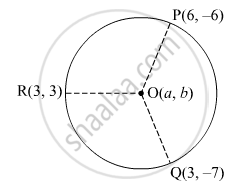Advertisements
Advertisements
Question
Find the coordinates of the centre of the circle passing through the points P(6, –6), Q(3, –7) and R (3, 3).
Solution

Let O(a, b) be the centre of the circle.
Let the points (6,- 6), (3, -7), and (3, 3) represent the points P, Q, and R on the circumference of the circle.
Distance from centre O to P, Q, R are found below using the Distance formula.
Distance Formula = `sqrt((x_2 - x_1)^2 + (y_2 - y_1)^2)`
From the figure ,
OP = OQ ...(radii of the same circle)
`∴ sqrt((a - 6)^2 + (b - (- 6))^2) = sqrt((a - 3)^2 + (b - (- 7))^2)`
`∴ sqrt((a - 6)^2 + (b + 6)^2) = sqrt((a - 3)^2 + (b + 7)^2)`
Squaring on both sides,
(a - 6)2 + (b + 6)2 = (a - 3)2 + (b + 7)2
∴ a2 - 12a + 36 + b2 + 12b + 36 = a2 - 6a + 9 + b2 + 14b + 49
∴ 3a + b = 7 ...(1)
OP = OR ...(radii of the same circle)
`∴ sqrt((a - 6)^2 + (b - (- 6))^2) = sqrt((a - 3)^2 + (b - 3)^2)`
`∴ sqrt((a - 6)^2 + (b + 6)^2) = sqrt((a - 3)^2 + (b - 3)^2)`
Squaring on both sides,
(a - 6)2 + (b + 6)2 = (a - 3)2 + (b - 3)2
∴ a2 - 12a + 36 + b2 + 12b + 36 = a2 - 6a + 9 + b2 - 6b + 9
54 = 6a + 18
∴ a - 3b = 9 ...(2)
Multiplying (2) with 3, we get,
∴ 3a - 9b = 27 ...(3)
Subtracting equation (3) from (1),
\[\begin{array}{l}
\phantom{\texttt{0}}\texttt{3a + b = 7}\\ \phantom{\texttt{}}\texttt{-3a - 9b = 27}\\ \hline\phantom{\texttt{}}\texttt{(-) (+) (-)}\\ \hline \end{array}\]
∴ 10b = - 20
∴ b = - 2
Substituting b = - 2 in equation (1),
3a + b = 7
3a - 2 = 7
3a = 7 + 2
3a = 9
a = 3
Coordinates of centre of the circle are (3, -2) .
APPEARS IN
RELATED QUESTIONS
Let ABCD be a square of side 2a. Find the coordinates of the vertices of this square when The centre of the square is at the origin and coordinate axes are parallel to the sides AB and AD respectively.
The base PQ of two equilateral triangles PQR and PQR' with side 2a lies along y-axis such that the mid-point of PQ is at the origin. Find the coordinates of the vertices R and R' of the triangles.
Prove that the points A(-4,-1), B(-2, 4), C(4, 0) and D(2, 3) are the vertices of a rectangle.
If three consecutive vertices of a parallelogram are (1, -2), (3, 6) and (5, 10), find its fourth vertex.
If the coordinates of the mid-points of the sides of a triangle be (3, -2), (-3, 1) and (4, -3), then find the coordinates of its vertices.
Points P, Q, R and S divide the line segment joining the points A(1,2) and B(6,7) in five equal parts. Find the coordinates of the points P,Q and R
Show that `square` ABCD formed by the vertices A(-4,-7), B(-1,2), C(8,5) and D(5,-4) is a rhombus.
The distance of the point P (4, 3) from the origin is
Find the ratio in which the line segment joining the points A(3, −3) and B(−2, 7) is divided by the x-axis. Also, find the coordinates of the point of division.
If the points A(−2, 1), B(a, b) and C(4, −1) ae collinear and a − b = 1, find the values of aand b.
If the distance between the points (3, 0) and (0, y) is 5 units and y is positive. then what is the value of y?
If P (x, 6) is the mid-point of the line segment joining A (6, 5) and B (4, y), find y.
If the area of the triangle formed by the points (x, 2x), (−2, 6) and (3, 1) is 5 square units , then x =
The distance of the point (4, 7) from the y-axis is
If points A (5, p) B (1, 5), C (2, 1) and D (6, 2) form a square ABCD, then p =
If the line segment joining the points (3, −4), and (1, 2) is trisected at points P (a, −2) and Q \[\left( \frac{5}{3}, b \right)\] , Then,
If P(2, 4), Q(0, 3), R(3, 6) and S(5, y) are the vertices of a parallelogram PQRS, then the value of y is
Find the point on the y-axis which is equidistant from the points (5, −2) and (−3, 2).
Point (0, –7) lies ______.
